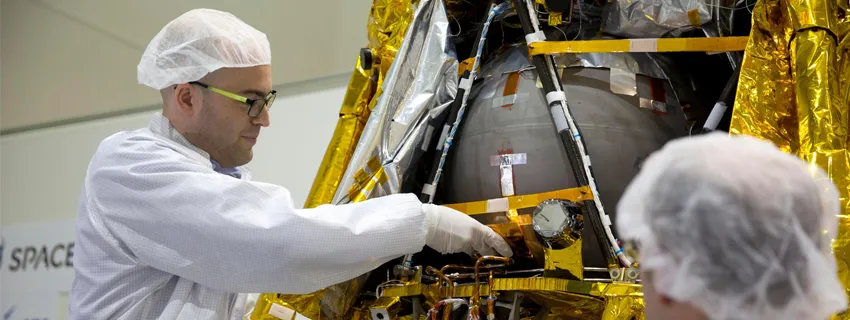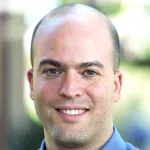
Photo courtesy AP Photo/Ariel Schalit: In this December 2018 photograph, Yonatan Winetraub, left, inserts a time capsule into the SpaceIL lunar module.
Stanford News - March 7th, 2019 - by Nathan Collins
Yonatan Winetraub, a graduate student in biophysics, had seen a few rocket launches before, but this time he had a special vantage point.
For this one, he stood on the launch site at Cape Canaveral. An organization he co-founded as a master’s student was about to launch a spacecraft headed for the moon.
“It was amazing experience. The skies went bright yellow-orange, and the moon was just coming up as the rocket flew over the horizon,” said Winetraub, who is also a Stanford Bio-X Bowes Graduate Student Fellow.
The Feb. 21 launch aboard a SpaceX Falcon rocket was the culmination of years of work by Winetraub’s nonprofit SpaceIL, which he founded in 2011 with friends and fellow engineers Yariv Bash and Kfir Damari. Back then, the trio were competing for the Google Lunar XPRIZE and dreamed of sending the first Israeli lander to the moon. Although the XPRIZE was cancelled last year, the team worked with Israeli Aerospace Industries to prepare their lander – Beresheet, the Hebrew word for “genesis” or “in the beginning” – for a trip to the moon.
During the day, Winetraub develops new ways to measure how cancer cells communicate with each other, with the ultimate goal of understanding how those cells adapt and learn to avoid our immune systems. But he has long dreamed of space. At 14, he wrote a paper for a science fair on how to change the rules of basketball for play on the moon. He later attended International Space University at NASA’s Ames Research Center, where he first learned about the Lunar XPRIZE.
Soon after, a friend introduced him to Bash and Damari. The friend reasoned that the three were “crazy enough to meet each other.”
“We clicked,” Winetraub remembered.
Beresheet’s main mission, Winetraub said, is to investigate the moon’s strange magnetic field, which unlike Earth’s points in various different directions depending on where it’s measured. For that part of the project, SpaceIL is collaborating with scientists at the Weitzmann Institute and at the University of California, Los Angeles.
But there is an educational mission as well. “We can do a lot more than land on the moon. We can help inspire kids to be interested in science and engineering,” Winetraub said. “We need their hearts and minds in science, and a moon lander excites them. They know that if they study now, they can build their own rocket one day.”

